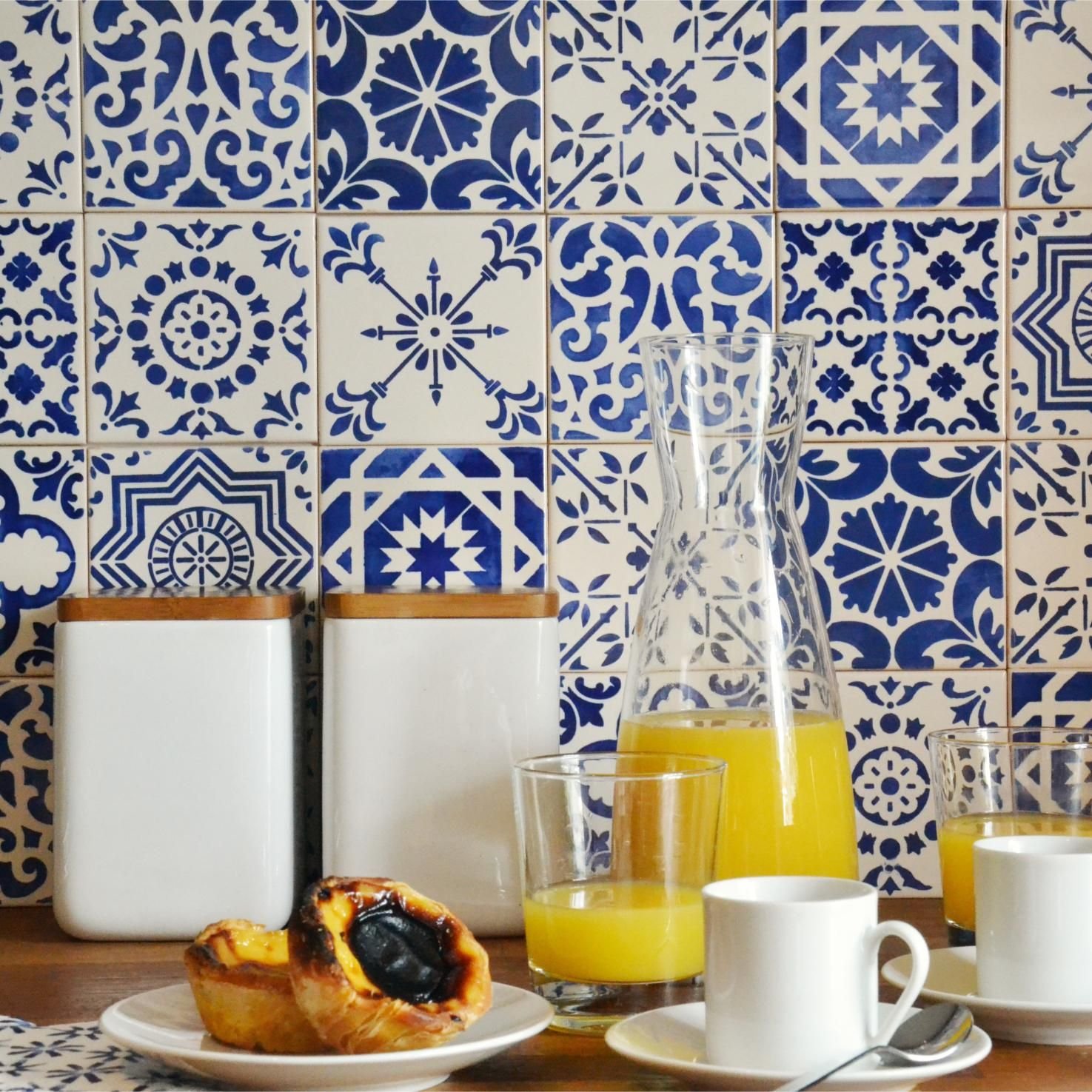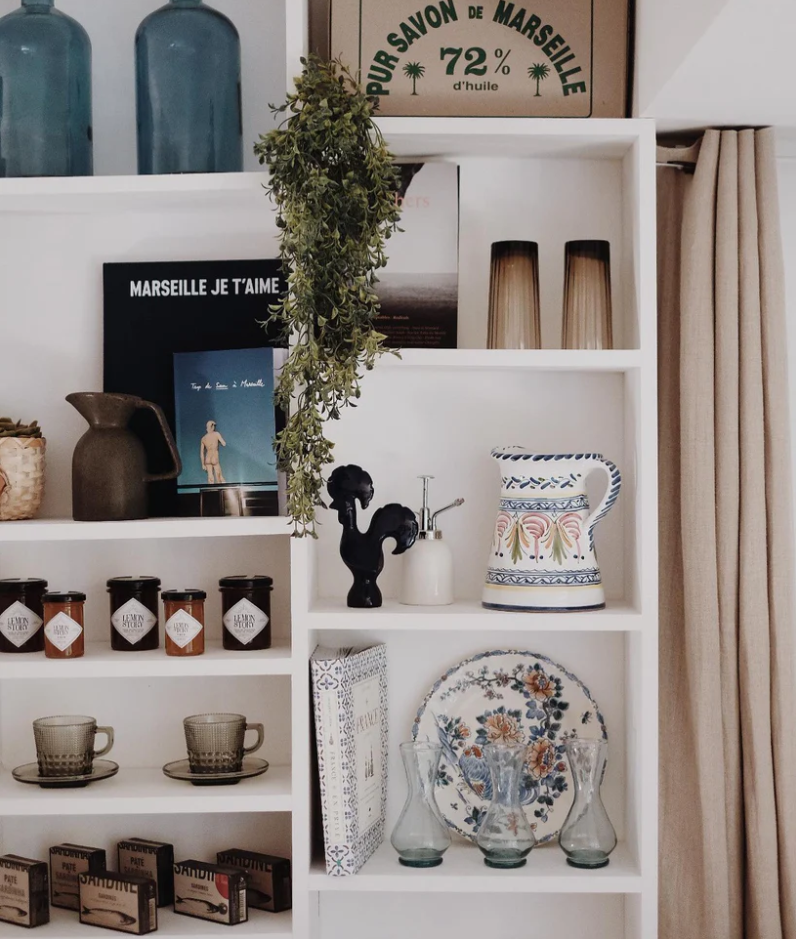Portuguese Architecture & Decoration
After several years of being immersed in Portuguese architecture, decoration, and history, it's time to share it with you. So, I'm taking you with me through the centuries and the influences of this unique architecture and decoration.
Royal power & Architecture
First and foremost, the royalty placed great importance on artistic and architectural development with the organization of the country's urban spaces.
Manuel I, in particular, invoked a style unique to the Renaissance period later named "Manueline."
Through this, he sought to affirm his power with the construction of the Paço da Ribeira (Royal Palace) and the Royal Hospital of All Saints. This also served to highlight the country's maritime strength with organic ornamentations made of ropes, armillary spheres, and royal coats of arms on white stone buildings and blue hues in decorative art.
Azulejos of Miradouro de Santa Luzia representing praca do comercio
Credits : Studio Bisson
It can still be seen today, mainly in the villages around Porto, and in Lisbon with the Belém Tower or the Jerónimos Monastery.
Belém Tower and Jeronimos monastery
Credits : Studio Bisson
The Romanesque and Gothic style arrived late in Portugal following the changes to these Manueline buildings under John III, such as the Convent of Christ, with the aim this time of expressing the power of the order and religion. Started by the Portuguese Diogo de Arruda and continued by João de Castilho (a Spaniard inspired by Italian Romanesque architecture), John III was particularly sensitive to this style.
Since then, architecture has been influenced by many foreign Mediterranean architects (Italians, Spaniards, French, Moroccans...).
The "azulejos" imported from the great discoveries & architecture
The "azulejos" are part of the ancient decorative art of Portugal and are integrated into palaces, churches, and exterior facades through the exploration and discoveries of the East, influenced by the art of Andalusian, Chinese, and Indian ceramics.
The term "azulejos" comes from the Arabic "al-zulaydi," meaning "polished small stone." These are ceramic tiles adorned with organic or geometric patterns that, when assembled, create a rhythm or a fresco in a single piece. Their designs reflect the artistic movements of the periods in which they were created.
The same principle can be found on the sidewalks and cobblestone streets of Lisbon, with small black, gray, and white cobblestones arranged on the ground to reproduce a chosen pattern often related to the sea and the Age of Discoveries. This ancient art reemerged after the earthquake of 1755.
Zoom on the paved streets of Lisbon
Credits : Studio Bisson
The earthquake & Lisbon architecture
After remaining in the Gothic style for a long time, the architecture of Lisbon's houses changed following the earthquake that devastated the city with a tsunami followed by a violent fire. Remnants of this architecture can still be seen in the Alfama district.
This catastrophe sparked a reconstruction of downtown Lisbon, especially the Belém district, on the foundations of the old plan and around royal remains like the Royal Palace. The new architecture favored aligned buildings and cornices, broader and more orderly streets, while enhancing public squares reflecting the ideals of the Enlightenment era. It is on these squares, such as Rossio or Commerce Square, where we find the distinctive cobblestone motifs associated with the novelty of grand squares. This reconstruction effort took approximately a century to complete!
Baixa (low city) with its streets & squares
Credits : Studio Bisson
Modern times & architecture
In 1970, a reconstruction movement emerged, influenced by post-war English trends. This led to the creation of "new" neighborhoods such as Bairro Alto, which translates literally to "high district."
Bairro Alto
Credits : Studio Bisson
In cities like Lisbon and Porto, there is a significant presence of expatriates. Indeed, Portugal has one of the highest rates of rural inhabitants in Western Europe; many Portuguese live outside urban areas or in suburbs. Most people who work in Lisbon actually live on the other side of the Tagus River or in the outskirts of the city. Additionally, there are more dwellings in Portugal than households, as at least half of Portuguese or foreign families own a country house or a vacation apartment.
In Lisbon, it is not uncommon to see buildings that appear abandoned because some owners inherit these properties but lack the means or see no reason to renovate them, and they cannot sell them in their current state. Portugal also has one of the highest poverty rates in Europe today.
Meanwhile, these buildings delight street art enthusiasts! It's an art form found in every corner of the streets in Lisbon.
Building with Street Art
Credits : Studio Bisson
Tourism, expatriates, and foreign students are crucial for sustaining this rich architecture. Portuguese legislation recognizes this and has decided to protect foreign buyers by offering advantageous taxation. This helps in the gradual renovation of these buildings and allows owners to cover renovation costs through apartment rentals.
In terms of decoration, there is a return to Lusitanian décor, taking advantage of the features of period constructions: high ceilings, moldings, wooden frameworks, and so on.
What is Lusitanian decor ?
Lusitanian decoration is the name given to ancient Portuguese decoration and pays tribute to the people who settled in the southwest of the Iberian Peninsula during antiquity, whom the Portuguese consider their ancestors.
Lusitanian interiors blend various stylistic techniques of Portuguese decorative art, ranging from neoclassical, through baroque and romanticism, to Italian Renaissance influences. This was exemplified by the architect and scenographer Luigi Chiari.
A diverse and rich ensemble featuring the authenticity of imposing furniture in dark colors (indigo green, purple, mustard yellow, ...) and warm materials (linen, wool).
Yet, it is also contrasted with colder textures such as furniture in copper or brass with golden and rosy accents influenced by traditional silversmithing.
Refer to the work of designers such as Boca do Lobo, Brabbu, and Toni Grilo.
We also find the famous shades of blue (from navy blue to turquoise) used alongside off-white, reminiscent of the sea. These tones are applied either through paint or via azulejos. They are typically found in wet areas like kitchens, bathrooms, or restaurant rooms. The intention is no longer to have them everywhere but to apply them sparingly as a nod to history.
Portuguese decoration is not very minimalist and has often been categorized as overwhelming, although nowadays it is evolving towards more balance by mixing sculpted objects, engravings, and patterns with simpler and modern pieces.
You can discover these national treasures at the Museum of Ancient Art in Lisbon.
The essentials
The indispensable fringed blanket: typically used as a bedspread. It's a complete decorative item that not only absorbs moisture but also provides warmth and softness. It's also used as a table runner, on Portuguese cushion covers, and typical woven rugs.
Villa de Noemi Marone Cinzano’s Living room
Credits: Miguel Flores Vianna
What about wood?
Wood has always been present in authentic royal furniture, libraries, carpentry, and interior decorations.
The most commonly used woods in Portugal are Pine, Oak, and Chestnut.
It's also important to note that Portugal is renowned for its cork leather industry (a material made from cork oak bark shavings), as the country has significant cork production. Modern Portuguese designers are increasingly enjoying creating furniture from cork. This trend is even spreading to international designers who appreciate new sustainable and versatile materials.
Conclusion
To conclude on Portuguese architecture and decoration, nothing is better than a visual demonstration. For this purpose, we have chosen to present João Mendes Ribeiro and Manuel and Francisco Aires Mateus, who we believe are worth exploring. They have opted for a specific architecture derived from Lusitanian architecture.
This style is called "White Architecture." They strive to find a precise balance between the past and the future, creating a connection between the interior and exterior to generate harmonious spaces within their environment.
White Architecture
Credits : Fahrenheit magazine

































